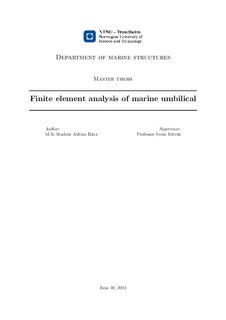| dc.contributor.author | Risa, Adrian Opheim | nb_NO |
| dc.date.accessioned | 2014-12-19T12:06:31Z | |
| dc.date.available | 2014-12-19T12:06:31Z | |
| dc.date.created | 2012-01-31 | nb_NO |
| dc.date.issued | 2011 | nb_NO |
| dc.identifier | 487364 | nb_NO |
| dc.identifier.uri | http://hdl.handle.net/11250/237930 | |
| dc.description.abstract | Background: Marine umbilicals play a vital role in oil and gas production fields. The oil and gas industry is in constant change, as the resources in the reservoirs are ever decreasing. Today oil and gas exploration takes place at increasing depths, and in harsher environments. This means that components like marine umbilicals are getting more advanced. Thus accurate structural analysis is important. The focus in this thesis is an umbilical consisting of 19 copper conductors. The goal is to model it in ABAQUS, and compare the results with laboratory testing.
Results: Stress distribution and fatigue calculations were the main focus. Ultimately, it was proven that ABAQUS was able to represent the umbilical's general behavior. However, due to computational limitations and limits in the material model, the result proved inaccurate. In particular, values for axial stress and strain, exceeds the expected values.
Conclusion: The model was able to represent the general behavior from the laboratory results. Effort should be made in the future to overcome the computational problems, and the material model should be revised. | nb_NO |
| dc.language | eng | nb_NO |
| dc.publisher | Norges teknisk-naturvitenskapelige universitet, Fakultet for ingeniørvitenskap og teknologi, Institutt for marin teknikk | nb_NO |
| dc.title | Finite element analysis of marine umbilical | nb_NO |
| dc.type | Master thesis | nb_NO |
| dc.contributor.department | Norges teknisk-naturvitenskapelige universitet, Fakultet for ingeniørvitenskap og teknologi, Institutt for marin teknikk | nb_NO |
